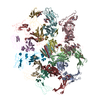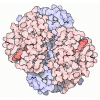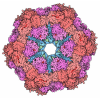+ Open data
Open data
- Basic information
Basic information
| Entry | Database: PDB / ID: 7k0c | ||||||
|---|---|---|---|---|---|---|---|
| Title | Structure of Secretory IgM Core | ||||||
 Components Components |
| ||||||
 Keywords Keywords |  IMMUNE SYSTEM / Immunoglobulin M IMMUNE SYSTEM / Immunoglobulin M | ||||||
| Function / homology |  Function and homology information Function and homology informationhexameric IgM immunoglobulin complex /  polymeric immunoglobulin receptor activity / immunoglobulin transcytosis in epithelial cells mediated by polymeric immunoglobulin receptor / dimeric IgA immunoglobulin complex / IgM B cell receptor complex / polymeric immunoglobulin binding / secretory dimeric IgA immunoglobulin complex / pentameric IgM immunoglobulin complex / monomeric IgA immunoglobulin complex / secretory IgA immunoglobulin complex ...hexameric IgM immunoglobulin complex / polymeric immunoglobulin receptor activity / immunoglobulin transcytosis in epithelial cells mediated by polymeric immunoglobulin receptor / dimeric IgA immunoglobulin complex / IgM B cell receptor complex / polymeric immunoglobulin binding / secretory dimeric IgA immunoglobulin complex / pentameric IgM immunoglobulin complex / monomeric IgA immunoglobulin complex / secretory IgA immunoglobulin complex ...hexameric IgM immunoglobulin complex /  polymeric immunoglobulin receptor activity / immunoglobulin transcytosis in epithelial cells mediated by polymeric immunoglobulin receptor / dimeric IgA immunoglobulin complex / IgM B cell receptor complex / polymeric immunoglobulin binding / secretory dimeric IgA immunoglobulin complex / pentameric IgM immunoglobulin complex / monomeric IgA immunoglobulin complex / secretory IgA immunoglobulin complex / Fc receptor signaling pathway / IgA binding / detection of chemical stimulus involved in sensory perception of bitter taste / polymeric immunoglobulin receptor activity / immunoglobulin transcytosis in epithelial cells mediated by polymeric immunoglobulin receptor / dimeric IgA immunoglobulin complex / IgM B cell receptor complex / polymeric immunoglobulin binding / secretory dimeric IgA immunoglobulin complex / pentameric IgM immunoglobulin complex / monomeric IgA immunoglobulin complex / secretory IgA immunoglobulin complex / Fc receptor signaling pathway / IgA binding / detection of chemical stimulus involved in sensory perception of bitter taste /  glomerular filtration / pre-B cell allelic exclusion / IgM immunoglobulin complex / CD22 mediated BCR regulation / azurophil granule membrane / receptor clustering / immunoglobulin complex, circulating / immunoglobulin receptor binding / positive regulation of respiratory burst / glomerular filtration / pre-B cell allelic exclusion / IgM immunoglobulin complex / CD22 mediated BCR regulation / azurophil granule membrane / receptor clustering / immunoglobulin complex, circulating / immunoglobulin receptor binding / positive regulation of respiratory burst /  humoral immune response / Scavenging of heme from plasma / humoral immune response / Scavenging of heme from plasma /  complement activation, classical pathway / complement activation, classical pathway /  antigen binding / Antigen activates B Cell Receptor (BCR) leading to generation of second messengers / Cell surface interactions at the vascular wall / B cell receptor signaling pathway / epidermal growth factor receptor signaling pathway / protein-macromolecule adaptor activity / antibacterial humoral response / protein-containing complex assembly / blood microparticle / defense response to Gram-negative bacterium / Potential therapeutics for SARS / antigen binding / Antigen activates B Cell Receptor (BCR) leading to generation of second messengers / Cell surface interactions at the vascular wall / B cell receptor signaling pathway / epidermal growth factor receptor signaling pathway / protein-macromolecule adaptor activity / antibacterial humoral response / protein-containing complex assembly / blood microparticle / defense response to Gram-negative bacterium / Potential therapeutics for SARS /  adaptive immune response / adaptive immune response /  receptor complex / receptor complex /  immune response / immune response /  innate immune response / Neutrophil degranulation / innate immune response / Neutrophil degranulation /  cell surface / protein homodimerization activity / cell surface / protein homodimerization activity /  extracellular space / extracellular exosome / extracellular region / extracellular space / extracellular exosome / extracellular region /  plasma membrane plasma membraneSimilarity search - Function | ||||||
| Biological species |   Homo sapiens (human) Homo sapiens (human) | ||||||
| Method |  ELECTRON MICROSCOPY / ELECTRON MICROSCOPY /  single particle reconstruction / single particle reconstruction /  cryo EM / Resolution: 3.3 Å cryo EM / Resolution: 3.3 Å | ||||||
 Authors Authors | Kumar, N. / Arthur, C.P. / Ciferri, C. / Matsumoto, M.L. | ||||||
 Citation Citation |  Journal: Structure / Year: 2021 Journal: Structure / Year: 2021Title: Structure of the human secretory immunoglobulin M core. Authors: Nikit Kumar / Christopher P Arthur / Claudio Ciferri / Marissa L Matsumoto /  Abstract: Immunoglobulins (Ig) A and M are the only human antibodies that form oligomers and undergo transcytosis to mucosal secretions via the polymeric Ig receptor (pIgR). When complexed with the J-chain (JC) ...Immunoglobulins (Ig) A and M are the only human antibodies that form oligomers and undergo transcytosis to mucosal secretions via the polymeric Ig receptor (pIgR). When complexed with the J-chain (JC) and the secretory component (SC) of pIgR, secretory IgA and IgM (sIgA and sIgM) play critical roles in host-pathogen defense. Recently, we determined the structure of sIgA-Fc which elucidated the mechanism of polymeric IgA assembly and revealed an extensive binding interface between IgA-Fc, JC, and SC. Despite low sequence identity shared with IgA-Fc, IgM-Fc also undergoes JC-mediated assembly and binds pIgR. Here, we report the structure of sIgM-Fc and carryout a systematic comparison to sIgA-Fc. Our structural analysis reveals a remarkably conserved mechanism of JC-templated oligomerization and SC recognition of both IgM and IgA through a highly conserved network of interactions. These studies reveal the structurally conserved features of sIgM and sIgA required for function in mucosal immunity. | ||||||
| History |
|
- Structure visualization
Structure visualization
| Movie |
 Movie viewer Movie viewer |
|---|---|
| Structure viewer | Molecule:  Molmil Molmil Jmol/JSmol Jmol/JSmol |
- Downloads & links
Downloads & links
- Download
Download
| PDBx/mmCIF format |  7k0c.cif.gz 7k0c.cif.gz | 510.4 KB | Display |  PDBx/mmCIF format PDBx/mmCIF format |
|---|---|---|---|---|
| PDB format |  pdb7k0c.ent.gz pdb7k0c.ent.gz | 422.4 KB | Display |  PDB format PDB format |
| PDBx/mmJSON format |  7k0c.json.gz 7k0c.json.gz | Tree view |  PDBx/mmJSON format PDBx/mmJSON format | |
| Others |  Other downloads Other downloads |
-Validation report
| Arichive directory |  https://data.pdbj.org/pub/pdb/validation_reports/k0/7k0c https://data.pdbj.org/pub/pdb/validation_reports/k0/7k0c ftp://data.pdbj.org/pub/pdb/validation_reports/k0/7k0c ftp://data.pdbj.org/pub/pdb/validation_reports/k0/7k0c | HTTPS FTP |
|---|
-Related structure data
| Related structure data |  22591MC M: map data used to model this data C: citing same article ( |
|---|---|
| Similar structure data |
- Links
Links
- Assembly
Assembly
| Deposited unit | 
|
|---|---|
| 1 |
|
- Components
Components
| #1: Protein |  / Poly-Ig receptor / Hepatocellular carcinoma-associated protein TB6 / Poly-Ig receptor / Hepatocellular carcinoma-associated protein TB6Mass: 65154.094 Da / Num. of mol.: 1 Source method: isolated from a genetically manipulated source Source: (gene. exp.)   Homo sapiens (human) / Gene: PIGR / Production host: Homo sapiens (human) / Gene: PIGR / Production host:   Cricetulus griseus (Chinese hamster) / References: UniProt: P01833 Cricetulus griseus (Chinese hamster) / References: UniProt: P01833 | ||||||
|---|---|---|---|---|---|---|---|
| #2: Protein | Mass: 40677.605 Da / Num. of mol.: 10 Source method: isolated from a genetically manipulated source Source: (gene. exp.)   Homo sapiens (human) / Gene: IGHM / Production host: Homo sapiens (human) / Gene: IGHM / Production host:   Cricetulus griseus (Chinese hamster) / References: UniProt: P01871 Cricetulus griseus (Chinese hamster) / References: UniProt: P01871#3: Protein | | Mass: 15611.458 Da / Num. of mol.: 1 Source method: isolated from a genetically manipulated source Source: (gene. exp.)   Homo sapiens (human) / Gene: JCHAIN, IGCJ, IGJ / Production host: Homo sapiens (human) / Gene: JCHAIN, IGCJ, IGJ / Production host:   Cricetulus griseus (Chinese hamster) / References: UniProt: P01591 Cricetulus griseus (Chinese hamster) / References: UniProt: P01591#4: Polysaccharide | 2-acetamido-2-deoxy-beta-D-glucopyranose-(1-4)-2-acetamido-2-deoxy-beta-D-glucopyranose |  / Mass: 424.401 Da / Num. of mol.: 1 / Mass: 424.401 Da / Num. of mol.: 1Source method: isolated from a genetically manipulated source Has ligand of interest | N | |
-Experimental details
-Experiment
| Experiment | Method:  ELECTRON MICROSCOPY ELECTRON MICROSCOPY |
|---|---|
| EM experiment | Aggregation state: PARTICLE / 3D reconstruction method:  single particle reconstruction single particle reconstruction |
- Sample preparation
Sample preparation
| Component | Name: Structure of the Human Secretory Immunoglobulin M Core Type: COMPLEX / Entity ID: #1-#3 / Source: RECOMBINANT | |||||||||||||||
|---|---|---|---|---|---|---|---|---|---|---|---|---|---|---|---|---|
| Molecular weight | Value: 480 kDa/nm / Experimental value: NO | |||||||||||||||
| Source (natural) | Organism:   Homo sapiens (human) Homo sapiens (human) | |||||||||||||||
| Source (recombinant) | Organism:   Cricetulus griseus (Chinese hamster) Cricetulus griseus (Chinese hamster) | |||||||||||||||
| Buffer solution | pH: 7.2 | |||||||||||||||
| Buffer component |
| |||||||||||||||
| Specimen | Conc.: 0.2 mg/ml / Embedding applied: NO / Shadowing applied: NO / Staining applied : NO / Vitrification applied : NO / Vitrification applied : YES / Details: Sample was monodisperse. : YES / Details: Sample was monodisperse. | |||||||||||||||
| Specimen support | Grid material: GOLD / Grid mesh size: 300 divisions/in. / Grid type: UltrAuFoil R0.6/1 | |||||||||||||||
Vitrification | Instrument: FEI VITROBOT MARK IV / Cryogen name: ETHANE / Humidity: 100 % / Chamber temperature: 277 K Details: Blot for 3.5 seconds before plunging with blot force 7. |
- Electron microscopy imaging
Electron microscopy imaging
| Experimental equipment |  Model: Titan Krios / Image courtesy: FEI Company |
|---|---|
| Microscopy | Model: FEI TITAN KRIOS |
| Electron gun | Electron source : :  FIELD EMISSION GUN / Accelerating voltage: 300 kV / Illumination mode: FLOOD BEAM FIELD EMISSION GUN / Accelerating voltage: 300 kV / Illumination mode: FLOOD BEAM |
| Electron lens | Mode: BRIGHT FIELD Bright-field microscopy / Nominal magnification: 165000 X / Cs Bright-field microscopy / Nominal magnification: 165000 X / Cs : 2.7 mm : 2.7 mm |
| Specimen holder | Cryogen: NITROGEN / Specimen holder model: FEI TITAN KRIOS AUTOGRID HOLDER |
| Image recording | Average exposure time: 0.2 sec. / Electron dose: 1.02 e/Å2 / Detector mode: COUNTING / Film or detector model: GATAN K2 SUMMIT (4k x 4k) |
| Image scans | Movie frames/image: 50 |
- Processing
Processing
| Software | Name: PHENIX / Version: 1.18.1_3865: / Classification: refinement | ||||||||||||||||||||||||
|---|---|---|---|---|---|---|---|---|---|---|---|---|---|---|---|---|---|---|---|---|---|---|---|---|---|
| EM software |
| ||||||||||||||||||||||||
CTF correction | Type: PHASE FLIPPING AND AMPLITUDE CORRECTION | ||||||||||||||||||||||||
| Symmetry | Point symmetry : C1 (asymmetric) : C1 (asymmetric) | ||||||||||||||||||||||||
3D reconstruction | Resolution: 3.3 Å / Resolution method: FSC 0.143 CUT-OFF / Num. of particles: 244123 / Symmetry type: POINT | ||||||||||||||||||||||||
| Refine LS restraints |
|
 Movie
Movie Controller
Controller









 PDBj
PDBj














